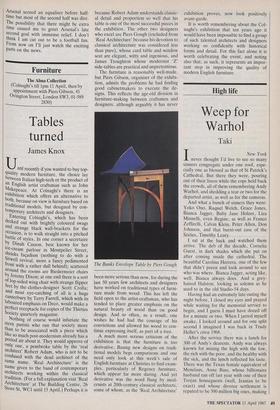Furniture
The Alma Collection (Colnaghi's till lpm 11 April, then by appointment with Piers Gibson, 41 Ovington Street, London 5W3, 01-589
2830)
Tables turned
James Knox
Until recently if you wanted to buy top- quality modern furniture, the choice lay eetween Italian high-tech or the product of an English artist craftsman such as John Makepeace. At Colnaghi's there is an exhibition which offers an alternative to both, because on view is furniture based on traditional models, but designed by con- temporary architects and designers. Entering Colnaghi's, which has been decked out with brightly coloured swags and strange black wall-brackets for the occasion, is to walk straight into a pitched battle of styles. In one corner a secretaire by Dinah Casson, best known for her ice:cream parlour in Montpelier Street, Shrieks fagadism (nothing to do with a Sitwell revival, more a fancy pedimented front with a rather dull behind); scattered around the rooms are Biedermeier chairs by Jeremy Dixon; at one end there is a sort of lop-sided wing chair with strange flipper feet by the clothes-designer Scott Crolla; and most eye-catching of all is a huge canterbury by Terry Farrell, which with its laboured emphasis on Deco, would make a perfect receptacle for copies of the Thirties Society quarterly magazine. Nothing of course would infuriate the stern purists who run that society more than to be associated with a piece which like so much post-modernism already has a Period air about it. They would approve of only one, a pembroke table by the 'real architect' Robert Adam, who is not to be Confused with the dead architect of the same name. 'Real Architecture' is the name given to the band of contemporary architects working within the classical tradition. (For a full explanation visit 'Real Architecture' at The Building Centre, 26 Store St, WC1 until 15 April.) Perhaps it is because Robert Adam understands classic- al detail and proportion so well that his table is one of the most successful pieces in the exhibition. The other two designers who excel are Piers Gough (excluded from 'Real Architecture' because his devotion to classical architecture was considered less than pure), whose card table and window seat are elegant, witty and ingenious, and James Troughton whose modernist 'Z' side-tables are practical and unpretentious. The furniture is reasonably well-made, but Piers Gibson, organiser of the exhibi- tion, admits the problems he had finding good cabinetmakers to execute the de- signs. This reflects the age-old division in furniture-making between craftsmen and designers; although arguably it has never The Banks Envelope Table by Piers Gough been more serious than now, for during the last 50 years few architects and designers have worked on traditional types of furni- ture made from wood. This has left the field open to the artist-craftsman, who has tended to place greater emphasis on the natural beauty of wood than on good design. And so often, as a result, one wishes he had had the courage of his convictions and allowed his wood to con- tinue expressing itself, as part of a tree.
A much more serious criticism of the exhibition is that the furniture is too derivative. Basing new designs on tradi- tional models begs comparisons and one need only look at this week's sale of English furniture at Christies to find exam- ples, particularly of Regency furniture, which appear far more daring. And yet derivative was the word flung by mod- ernists at 20th-century classical architects, some of whom, as the 'Real Architecture' exhibition proves, now look positively avant-garde.
It is worth remembering about the Col- naghi's exhibition that ten years ago it would have been impossible to find a group of such talented architects and designers working so confidently with historical forms and detail. For this fact alone it is worth celebrating the event, and noting also that, as such, it represents an impor- tant step in improving the quality of modern English furniture.
























































 Previous page
Previous page